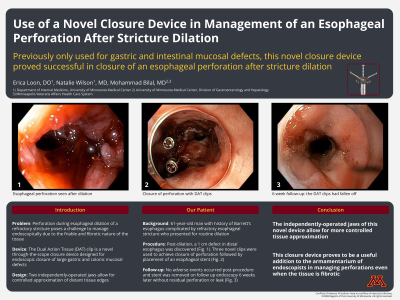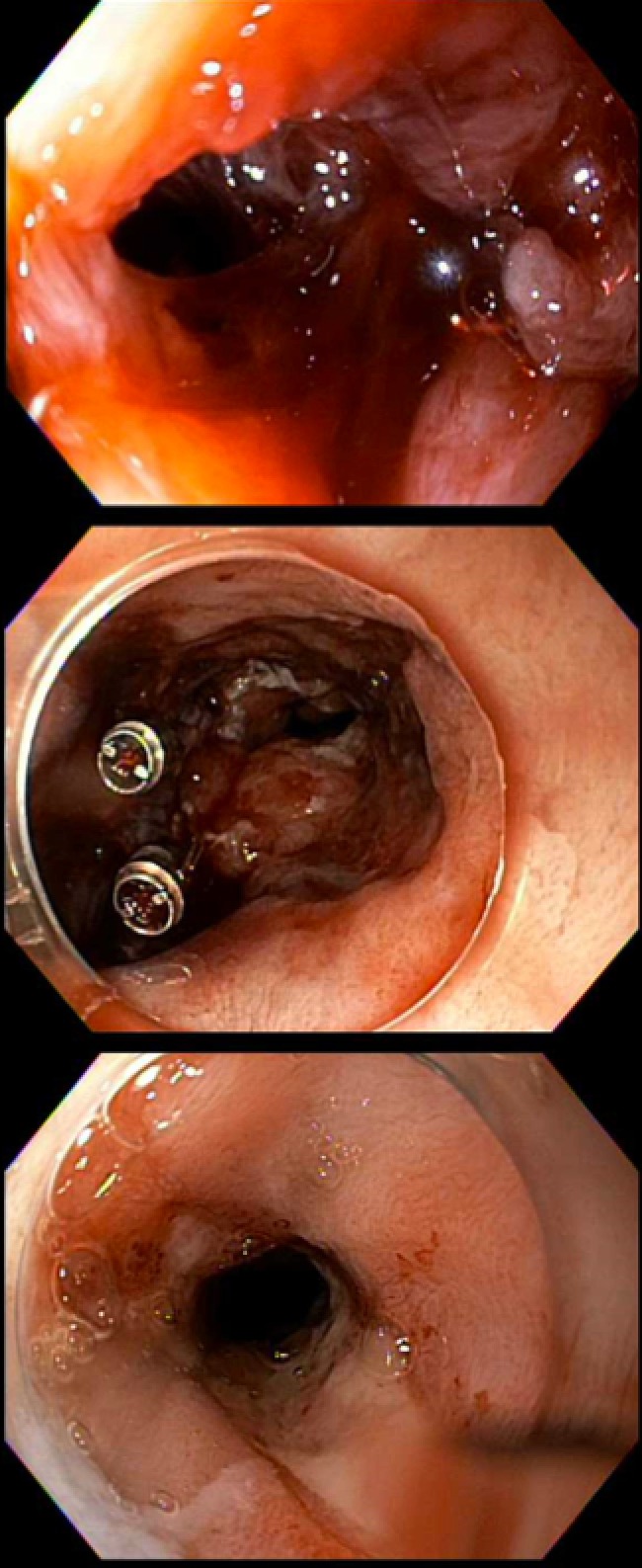Tuesday Poster Session
Category: General Endoscopy
P3431 - Use of a Novel Closure Device in Management of an Esophageal Perforation After Stricture Dilation
Tuesday, October 24, 2023
10:30 AM - 4:00 PM PT
Location: Exhibit Hall

Has Audio

Erica Loon, DO
University of Minnesota
Minneapolis, MN
Presenting Author(s)
Erica Loon, DO1, Natalie Wilson, MD1, Mohammad Bilal, MD2
1University of Minnesota, Minneapolis, MN; 2Minneapolis VA Medical Center, Minneapolis, MN
Introduction: Perforation during dilation of a refractory stricture can be challenging to manage endoscopically due to the friable and fibrotic nature of the tissue.
The Dual Action Tissue (DAT) clip is a novel through-the-scope (TTS) closure device designed for endoscopic closure of mucosal defects. Its unique trademark are two independently-operated jaws which allow for controlled approximation of distant opposing tissue edges. While there is emerging literature on the use of DAT clips for closure of resection defects, there is limited knowledge regarding their efficacy in managing an acute perforation. Here, we describe a patient who had an esophageal perforation after a dilation for refractory esophageal stricture and underwent successful endoscopic closure with DAT clips.
Case Description/Methods: A 61-year-old man with a history of Barrett’s esophagus complicated by refractory esophageal stricture was referred to us for dilation. An upper endoscopy was performed and a benign-appearing, intrinsic severe stenosis was found in the distal esophagus measuring 8 mm in diameter. Dilation was performed with a Savary dilator sequentially from 8 mm to 20 mm. Post-dilation inspection revealed a 1 cm defect in the distal esophagus consistent with esophageal perforation (Figure 1). Using the two independently-operated jaws of 3 DAT clips, the fibrotic edges of the defect were approximated and closure was achieved (Figure 2). Intra-procedural contrast injection was performed and did not reveal any contrast extravasation, indicating complete closure. A fully covered esophageal stent was placed at the end of the procedure for secondary closure.
The patient remained hemodynamically stable throughout the procedure and was admitted to the intensive care unit for broad spectrum antibiotics and close monitoring. No adverse events were experienced after the procedure and stent was removed on follow up endoscopy 6 weeks later (Figure 3) with no residual perforation or leak seen.
Discussion: Endoscopic closure of acute perforation with TTS clips in patients with esophageal strictures is typically challenging due to the fibrotic and friable nature of tissue in these cases. The independently-operated jaws of the DAT clip allow for more controlled tissue approximation. This function provided endoscopic closure of esophageal perforation in our case, proving the DAT clip to be a useful addition to the armamentarium of endoscopists.

Disclosures:
Erica Loon, DO1, Natalie Wilson, MD1, Mohammad Bilal, MD2. P3431 - Use of a Novel Closure Device in Management of an Esophageal Perforation After Stricture Dilation, ACG 2023 Annual Scientific Meeting Abstracts. Vancouver, BC, Canada: American College of Gastroenterology.
1University of Minnesota, Minneapolis, MN; 2Minneapolis VA Medical Center, Minneapolis, MN
Introduction: Perforation during dilation of a refractory stricture can be challenging to manage endoscopically due to the friable and fibrotic nature of the tissue.
The Dual Action Tissue (DAT) clip is a novel through-the-scope (TTS) closure device designed for endoscopic closure of mucosal defects. Its unique trademark are two independently-operated jaws which allow for controlled approximation of distant opposing tissue edges. While there is emerging literature on the use of DAT clips for closure of resection defects, there is limited knowledge regarding their efficacy in managing an acute perforation. Here, we describe a patient who had an esophageal perforation after a dilation for refractory esophageal stricture and underwent successful endoscopic closure with DAT clips.
Case Description/Methods: A 61-year-old man with a history of Barrett’s esophagus complicated by refractory esophageal stricture was referred to us for dilation. An upper endoscopy was performed and a benign-appearing, intrinsic severe stenosis was found in the distal esophagus measuring 8 mm in diameter. Dilation was performed with a Savary dilator sequentially from 8 mm to 20 mm. Post-dilation inspection revealed a 1 cm defect in the distal esophagus consistent with esophageal perforation (Figure 1). Using the two independently-operated jaws of 3 DAT clips, the fibrotic edges of the defect were approximated and closure was achieved (Figure 2). Intra-procedural contrast injection was performed and did not reveal any contrast extravasation, indicating complete closure. A fully covered esophageal stent was placed at the end of the procedure for secondary closure.
The patient remained hemodynamically stable throughout the procedure and was admitted to the intensive care unit for broad spectrum antibiotics and close monitoring. No adverse events were experienced after the procedure and stent was removed on follow up endoscopy 6 weeks later (Figure 3) with no residual perforation or leak seen.
Discussion: Endoscopic closure of acute perforation with TTS clips in patients with esophageal strictures is typically challenging due to the fibrotic and friable nature of tissue in these cases. The independently-operated jaws of the DAT clip allow for more controlled tissue approximation. This function provided endoscopic closure of esophageal perforation in our case, proving the DAT clip to be a useful addition to the armamentarium of endoscopists.

Figure: From top to bottom: Figure 1, 2, 3
Disclosures:
Erica Loon indicated no relevant financial relationships.
Natalie Wilson indicated no relevant financial relationships.
Mohammad Bilal: Boston Scientific – Consultant.
Erica Loon, DO1, Natalie Wilson, MD1, Mohammad Bilal, MD2. P3431 - Use of a Novel Closure Device in Management of an Esophageal Perforation After Stricture Dilation, ACG 2023 Annual Scientific Meeting Abstracts. Vancouver, BC, Canada: American College of Gastroenterology.
